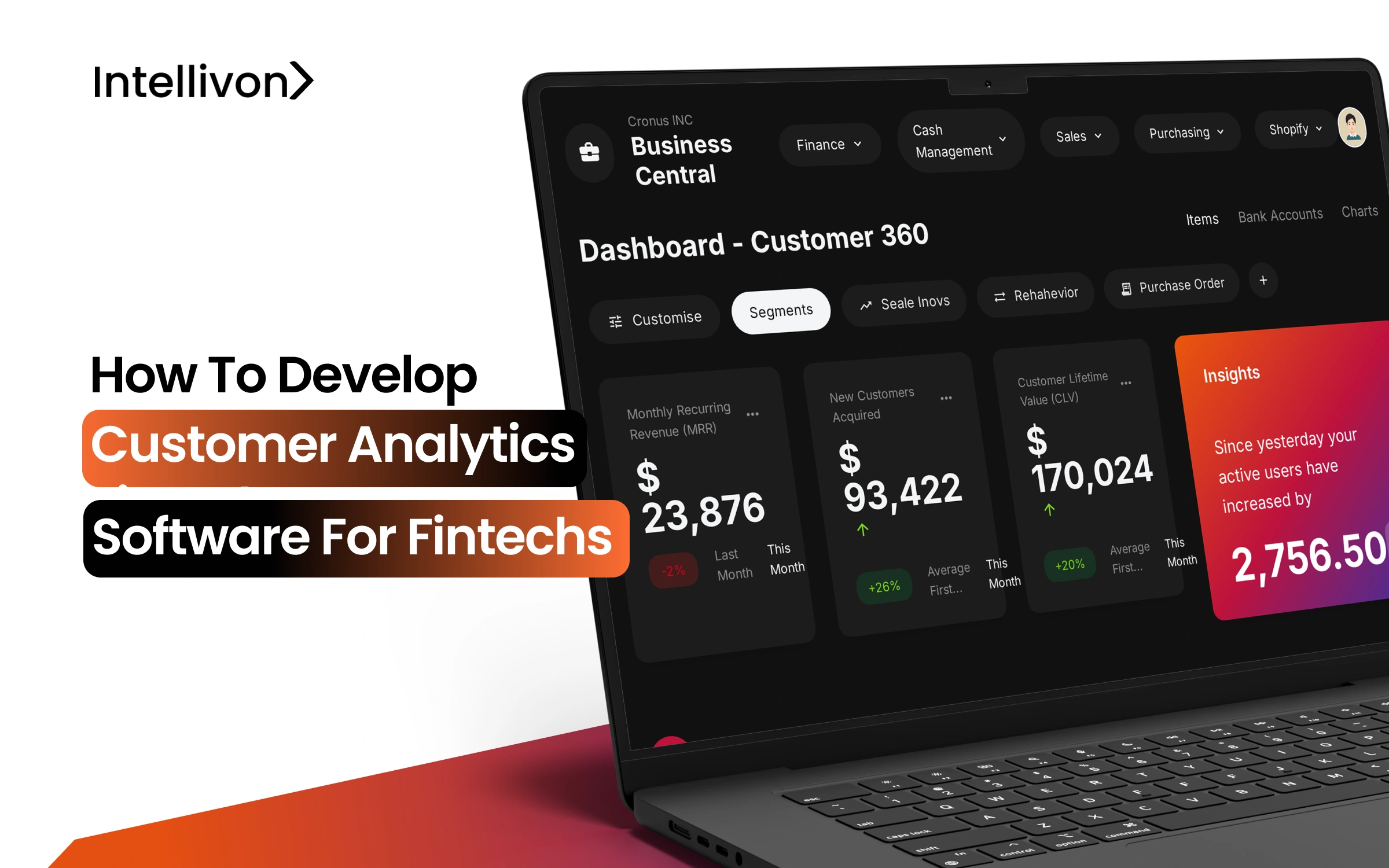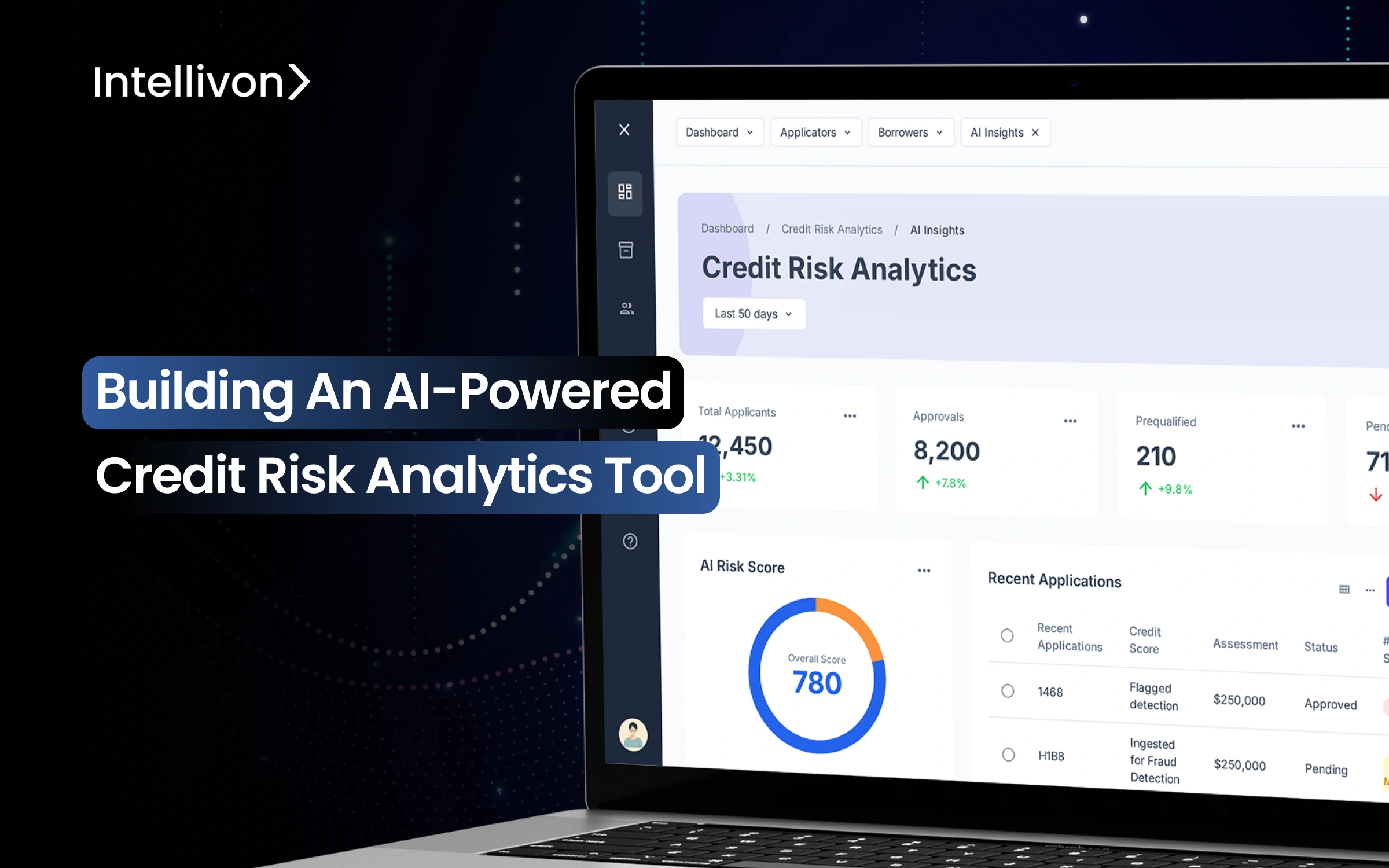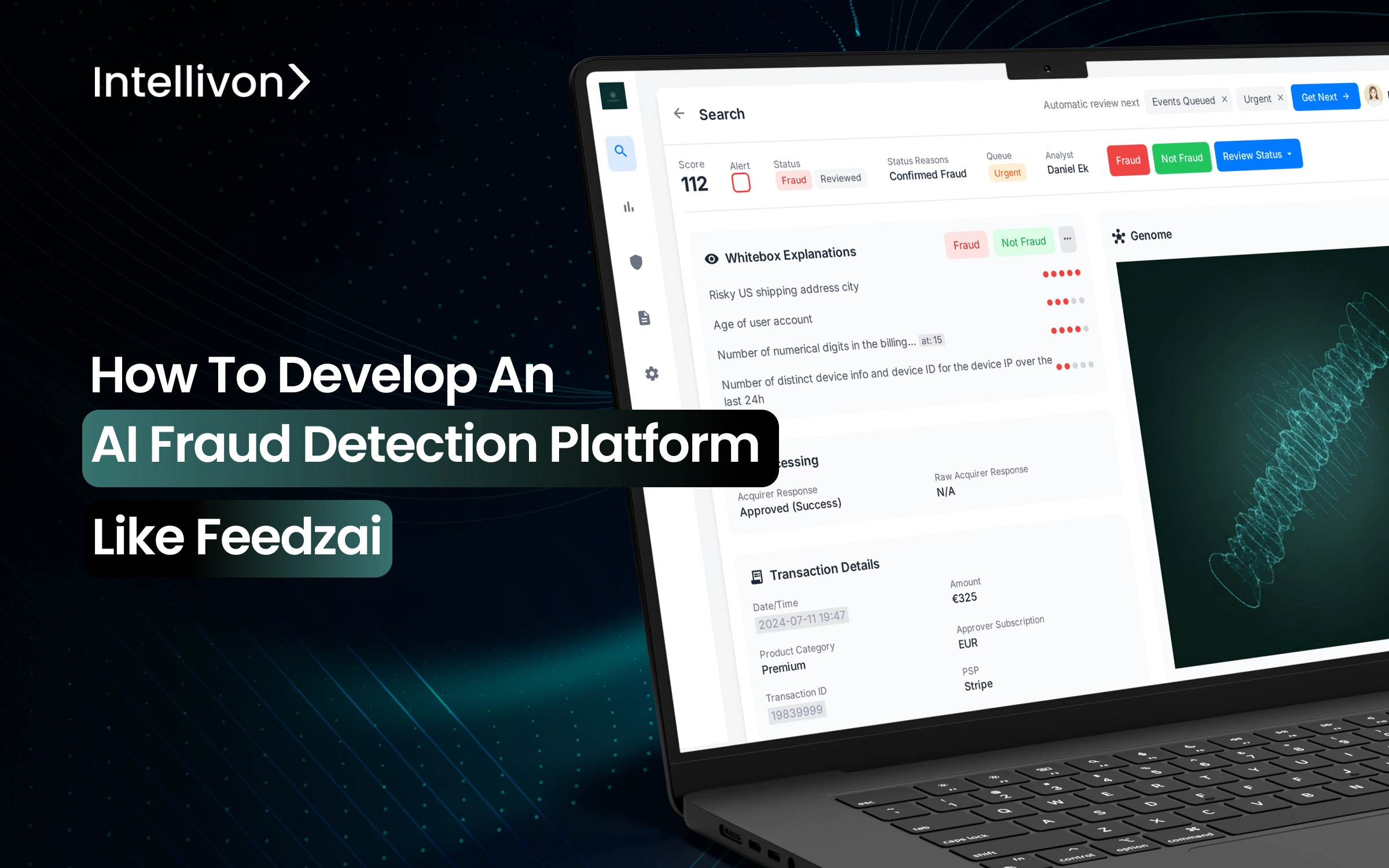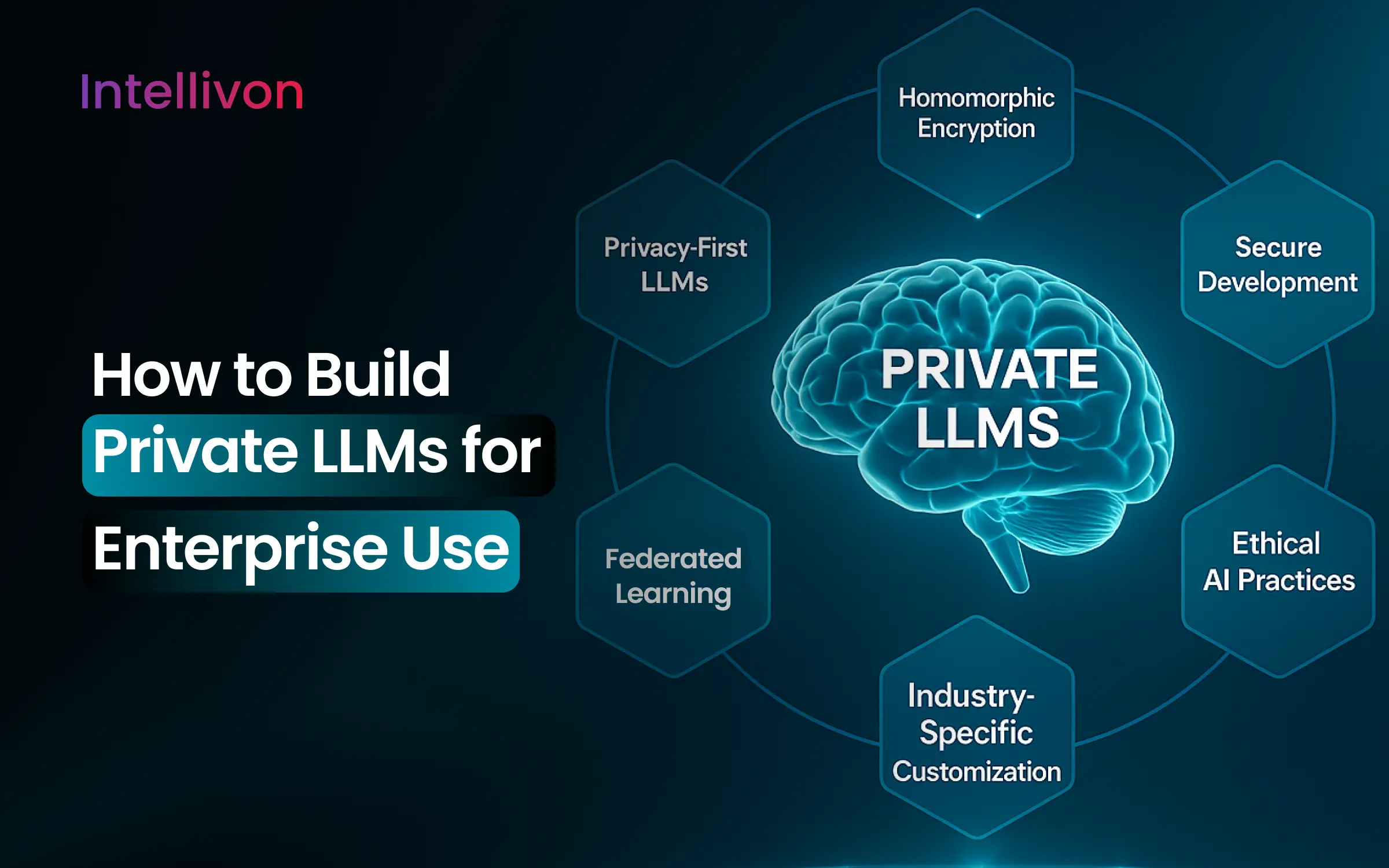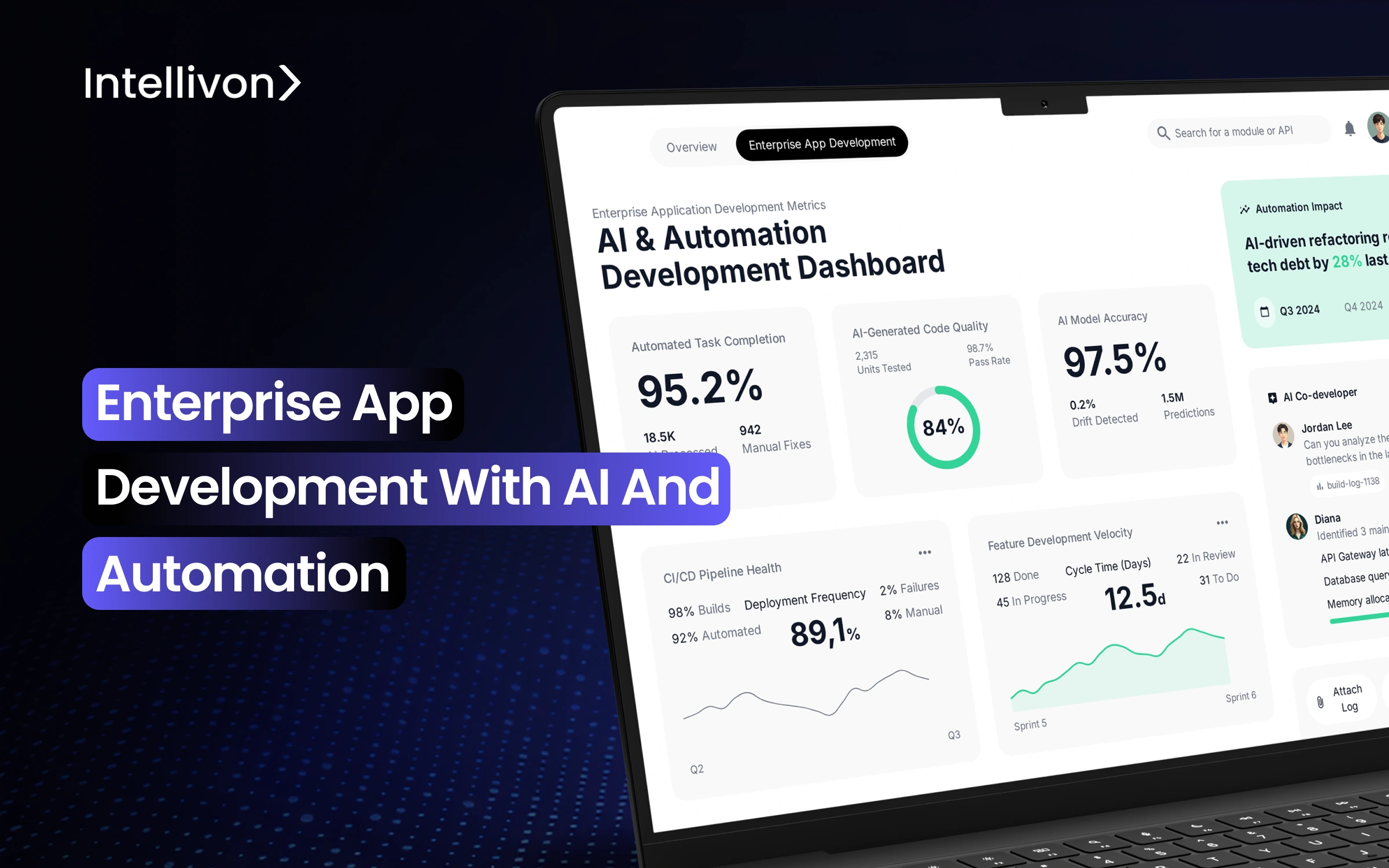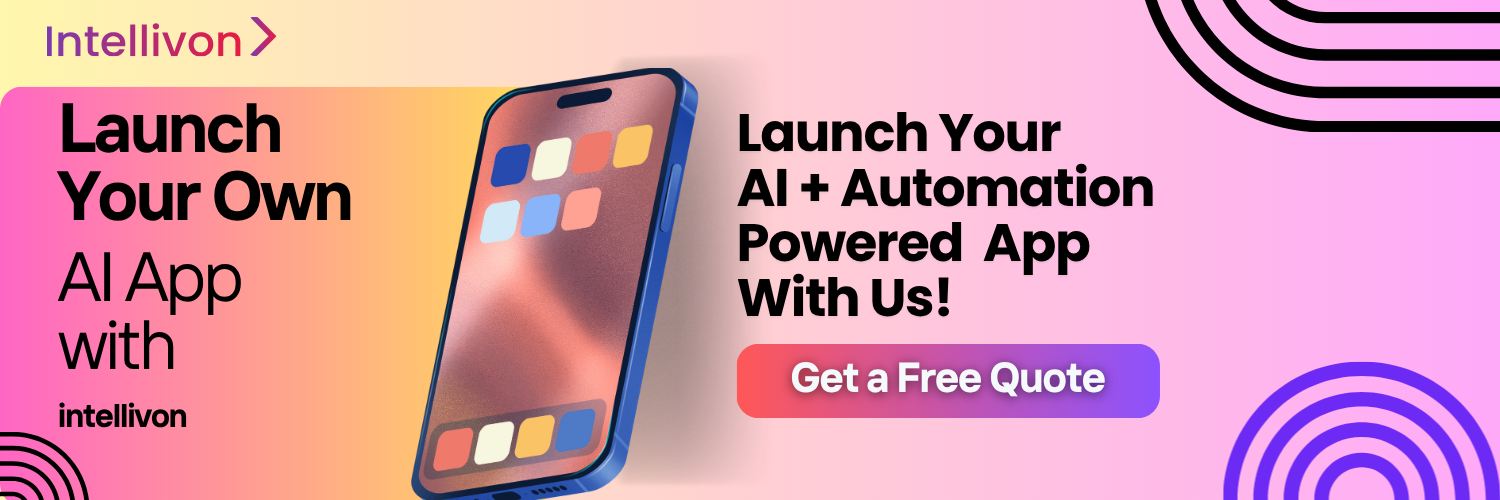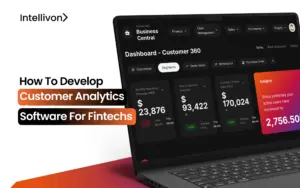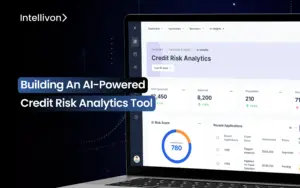Digital ecosystems are growing more complex, and enterprise apps are struggling to handle scale, integrate data, and meet the real-time demands of global business. Studies show that nearly 55-75% of enterprise applications fail to deliver their projected ROI because they cannot adapt quickly enough to market changes or support the volume of transactions a global business demands. This is where AI and automation change the fate by replacing traditional development methods. Enterprise apps built with AI and automation embed intelligence into decision-making and automate execution end-to-end. Through this, businesses can finally unlock scale, resilience, and measurable returns from their applications.
At Intellivon, we’ve seen this transformation firsthand. With over a decade of experience, we have built apps with AI and automation at the core for leading enterprises. The result is stronger ROI, scalable platforms, and enhanced consumer trust. In this blog, we will explore how AI and automation elevate enterprise apps and how Intellivon builds them from the ground up.
Why Enterprises Should Invest in AI and Automation-Powered Apps
The global enterprise artificial intelligence market size was estimated at USD 23.95 billion in 2024 and is projected to reach USD 1,55,210.3 million by 2030, growing at a CAGR of 37.6% from 2025 to 2030. This growth is being fueled by rising demand for automation, efficiency, and data-driven decision-making across industries.
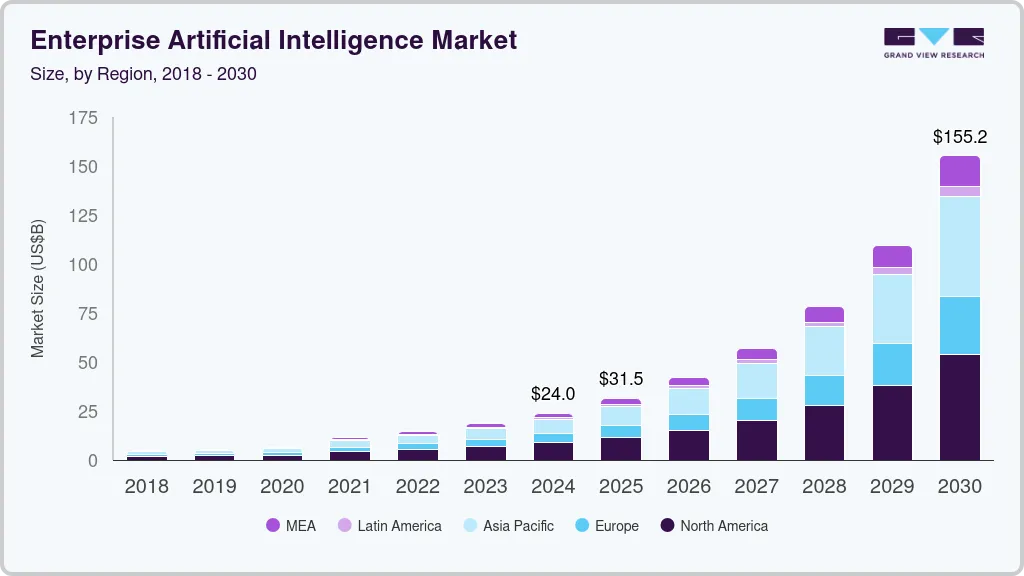
- The broader workflow automation market is growing at a high-teens to low-20s CAGR, depending on RPA, AI workflows, and integration scope.
- Stanford’s AI Index 2025 highlights rapid enterprise adoption, with organizations moving from pilots to scaled deployments.
- AI-driven automation delivers higher productivity, faster decisions, and cost savings, with ROI ranging from 1.5x to 3x over multi-year horizons.
- Automation in testing, release orchestration, and supply chain optimization improves throughput, reduces defects, and speeds up time-to-market.
These trends confirm that AI and automation are no longer optional experiments. They are becoming essential enablers of enterprise scalability, resilience, and long-term ROI.
How AI and Automation Power Enterprise Apps
Traditional enterprise apps were built to process transactions, enforce workflows, and record data. While effective for their time, they lack the agility to keep pace with today’s digital demands. Enterprises now need apps that respond in real time, learn from data, and act autonomously across business functions. AI and automation provide the capabilities to make that possible.
Artificial intelligence enables applications to analyze structured and unstructured data, detect trends, and generate predictions at a scale impossible for human teams alone. With this intelligence, enterprises can forecast risks, personalize customer journeys, optimize supply chains, or detect anomalies before they escalate into costly failures.
Automation complements AI by ensuring those insights translate into action. It embeds execution directly into workflows, whether through robotic process automation, decision engines, or orchestration across systems. This eliminates manual handoffs, reduces errors, and accelerates cycle times, thereby delivering tangible productivity and cost gains.
The real power lies in combining the two. An app that predicts equipment failure creates little value unless it also triggers automated maintenance workflows and adjusts supply chain inventory. Similarly, a customer-facing system that personalizes recommendations becomes far more impactful when it can instantly update CRM records, adjust stock, and process the purchase. AI supplies the foresight, automation delivers the follow-through.
For global enterprises balancing growth, compliance, and efficiency, this shift is transformative. Apps developed with AI and automation evolve from static tools into strategic assets, thereby enabling organizations to scale faster, control costs, and strengthen their competitive position in the market.
How Enterprise Apps Succeed Using AI and Automation
Every industry is redefining the role of enterprise apps through AI and automation. What were once static systems limited to transactions and reporting are now evolving into adaptive platforms that think, learn, and act in real time. The result is a new generation of apps that not only support business functions but also actively shape growth, efficiency, and resilience.
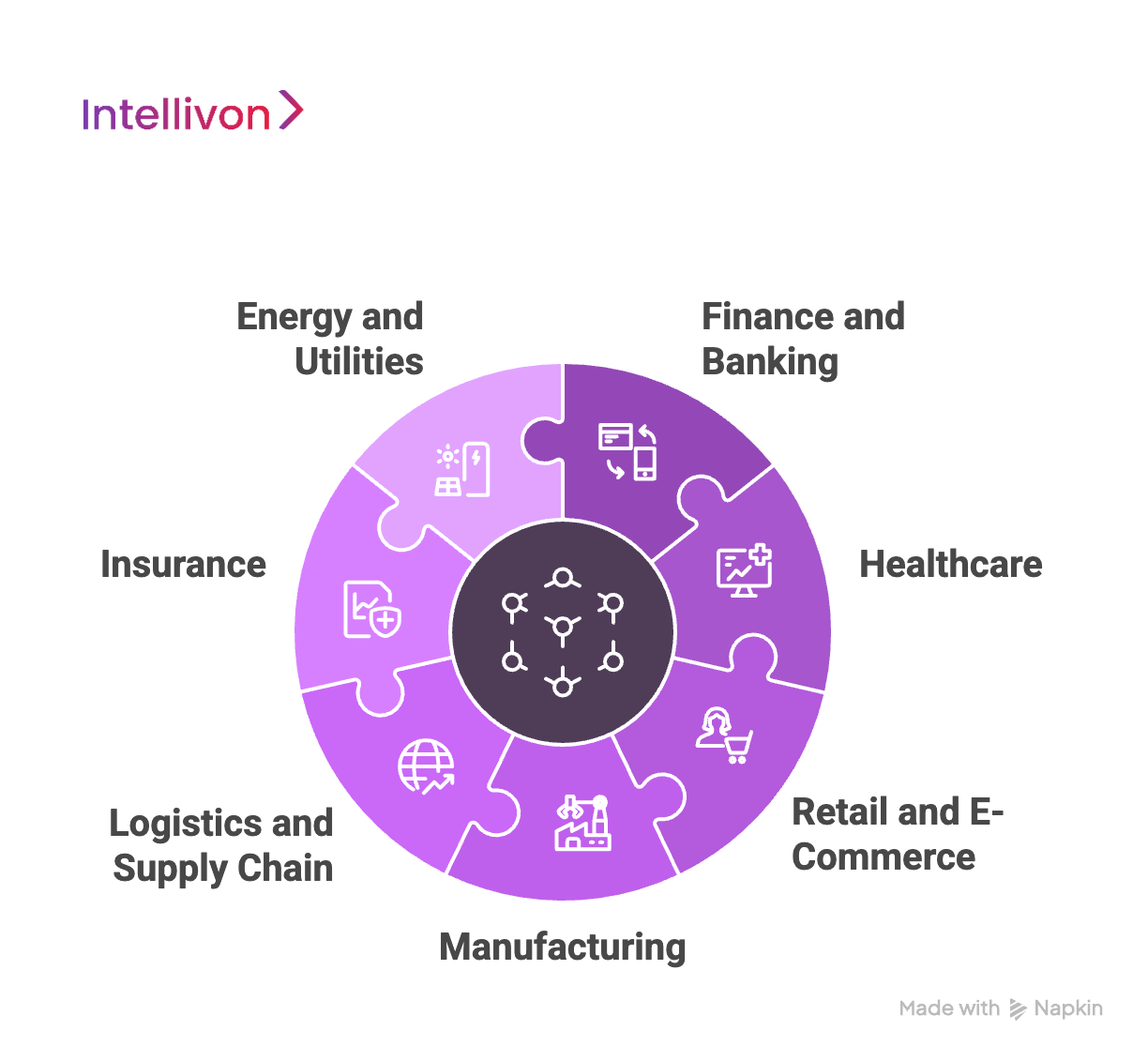
1. Finance and Banking
AI and automation are reshaping financial services by enabling faster decisions, tighter compliance, and more reliable customer experiences. Enterprise apps in this space are becoming predictive, adaptive, and deeply embedded in the customer and risk management journey.
A. Fraud Detection Apps
Fraud detection apps leverage AI to scan millions of transactions per second, identifying unusual spending patterns, geographic anomalies, or behavioral irregularities.
When combined with automation, these apps can immediately flag or freeze suspicious activity, notify compliance officers, and generate detailed audit trails. The speed and accuracy reduce fraud losses and reassure customers of security.
B. Credit Risk Assessment Apps
Traditional credit models often miss contextual signals that define true customer risk. AI-powered apps integrate alternative data, from digital payment behavior to market sentiment, to create richer profiles.
Automation ensures that approvals or rejections are executed instantly, allowing lenders to scale their credit offerings while maintaining regulatory compliance and lowering default rates.
C. Regulatory Compliance Apps
Compliance remains one of the largest cost centers in finance. AI apps can interpret changing regulations through natural language processing, identify impacted processes, and automate reporting tasks.
By embedding automation into these workflows, enterprises cut manual effort, lower audit risk, and respond to regulators faster, ensuring smoother operations at scale.
Real-World Example: American Express
American Express runs AI-driven fraud detection apps that continuously analyze global transaction flows. These systems prevent billions in potential losses every year by spotting anomalies within milliseconds. Automation ensures legitimate customer purchases proceed without disruption, balancing fraud protection with smooth user experiences.
2. Healthcare
In healthcare, AI and automation are redefining how providers deliver care, manage compliance, and streamline operations. Enterprise apps in this sector are being built to not only support clinicians but also enhance patient outcomes, reduce administrative burden, and strengthen trust in sensitive, regulated environments.
A. Predictive Diagnostics Apps
AI-driven diagnostic apps analyze imaging scans, lab results, and patient history to flag early indicators of disease.
When paired with automation, these apps can schedule follow-up tests, alert physicians, and trigger care pathways. This accelerates treatment decisions while reducing the risk of oversight.
B. Patient Engagement Apps
Healthcare engagement apps powered by AI act as personalized assistants for patients. They answer questions, remind patients of medications, and monitor symptoms through conversational interfaces.
Automation ensures that if concerning data is detected, alerts are routed to the right medical team without delay, improving patient safety and satisfaction.
C. Claims Processing Apps
Administrative complexity is one of the biggest cost drivers in healthcare. AI apps review claim forms for errors, validate medical codes, and detect fraudulent submissions.
With automation layered in, approved claims can be processed instantly while questionable cases are routed for review, reducing payment cycles and operational costs.
Real-World Example: Mayo Clinic
Mayo Clinic leverages AI-powered apps to support diagnostics across radiology and pathology. These tools detect subtle anomalies in scans that may indicate disease earlier than traditional methods. Combined with workflow automation, results are routed seamlessly to physicians and patients, reducing delays and enabling higher-quality care across the system.
3. Retail and E-Commerce
Retailers and e-commerce enterprises are under pressure to deliver seamless, hyper-personalized experiences while keeping costs under control. AI and automation are powering apps that analyze consumer behavior, optimize supply chains, and personalize every customer interaction at scale.
A. Personalized Shopping Apps
AI-driven retail apps study purchase history, browsing behavior, and contextual signals to make real-time product recommendations.
With automation layered in, these apps can trigger personalized promotions, update loyalty points, and streamline checkout flows, resulting in higher conversion rates and stronger customer loyalty.
B. Inventory and Supply Chain Automation Apps
Managing stock across thousands of SKUs and multiple geographies is complex. AI apps forecast demand trends with precision, while automation ensures replenishment orders, warehouse allocations, and vendor communications happen automatically.
This reduces stockouts, cuts carrying costs, and ensures customers find what they want, when they want it.
C. Dynamic Pricing Apps
E-commerce apps enhanced with AI analyze competitor pricing, demand signals, and seasonality to set optimal prices in real time.
Automation applies these changes instantly across catalogs and sales channels, ensuring enterprises remain competitive while protecting margins without manual intervention.
Real-World Example: Walmart
Walmart leverages AI-powered supply chain apps that forecast demand across regions and automate inventory management in real time. These systems not only reduce waste and improve logistics efficiency but also strengthen customer experience by ensuring products remain available both online and in-store at scale.
4. Manufacturing
Manufacturers are under constant pressure to maintain quality, minimize downtime, and manage complex supply networks. AI and automation are enabling enterprise apps that anticipate issues, automate responses, and optimize production at scale, creating a measurable impact on both efficiency and cost.
A. Predictive Maintenance Apps
AI-powered apps analyze sensor data from machinery to detect anomalies that signal potential failures. By predicting breakdowns in advance, they allow enterprises to schedule repairs proactively.
Automation then triggers maintenance orders, assigns technicians, and adjusts production schedules, reducing costly unplanned downtime.
B. Quality Assurance Apps
Traditional quality checks rely on sampling and human inspection, which can miss defects. AI-driven vision systems integrated into enterprise apps inspect every product on the line.
When automation identifies an anomaly, the system can halt production, notify supervisors, and record defect data for continuous improvement.
C. Supply Chain Optimization Apps
AI algorithms forecast demand and identify bottlenecks across supplier networks. With automation integrated, enterprise apps can automatically adjust supplier orders, reroute shipments, or update ERP systems in real time.
This minimizes delays, reduces inventory carrying costs, and ensures supply chains remain resilient.
Real-World Example: Siemens
Siemens uses AI-enhanced manufacturing apps to monitor equipment health and optimize production. These systems automatically adjust workloads, schedule predictive maintenance, and alert operators when anomalies are detected. The combination of intelligence and automation has significantly reduced downtime while improving overall equipment efficiency.
5. Logistics and Supply Chain
Global logistics networks face increasing complexity from fluctuating demand, geopolitical pressures, and customer expectations for speed and transparency. AI and automation are transforming enterprise apps into intelligent orchestration systems that continuously adapt to disruptions and optimize performance end-to-end.
A. Route Optimization Apps
AI-powered apps process real-time traffic, weather, and delivery constraints to generate the most efficient routes for fleets.
With automation embedded, these apps adjust driver schedules, reroute shipments on the fly, and notify customers automatically, reducing fuel costs and improving on-time delivery rates.
B. Fleet Management Apps
Managing thousands of vehicles across geographies requires constant monitoring. AI-enhanced apps track telematics data such as fuel consumption, driver behavior, and maintenance needs.
Automation ensures alerts are escalated instantly, repairs are scheduled, and underperforming assets are reassigned, improving fleet utilization and safety.
C. Real-Time Tracking and Visibility Apps
Supply chain leaders increasingly demand end-to-end visibility. AI apps consolidate data from IoT sensors, RFID tags, and ERP systems to monitor shipments globally.
Automation then updates customers, flags delays, and triggers contingency workflows, ensuring supply chain transparency and resilience.
Real-World Example: UPS ORION
UPS’s ORION app is a benchmark in logistics innovation. It uses advanced AI algorithms to optimize millions of daily delivery routes. With automation tightly integrated, ORION executes route changes instantly, helping UPS save hundreds of millions in fuel and operational costs while improving customer service worldwide.
6. Insurance
Insurance enterprises are rapidly adopting AI and automation to improve underwriting accuracy, reduce claims processing time, and strengthen fraud prevention. Enterprise apps in this industry are being designed to manage risk intelligently while creating faster, more transparent experiences for customers.
A. Claims Automation Apps
Claims processing has long been plagued by paperwork and manual reviews. AI-powered claims apps analyze damage photos, customer histories, and policy details to predict claim outcomes.
Automation then routes approvals, initiates payouts, or escalates cases instantly, reducing turnaround times from weeks to hours.
B. Underwriting Risk Assessment Apps
AI-driven underwriting apps evaluate applicants by combining traditional actuarial data with new sources such as lifestyle data, IoT wearables, and behavioral analytics.
Automation ensures that once risk scores are determined, quotes and policies are generated in real time, accelerating new business acquisition while maintaining compliance.
C. Fraud Detection Apps
Fraudulent claims cost the insurance sector billions annually. AI apps analyze claims for unusual patterns or inconsistencies, cross-referencing data across multiple channels.
Automation enables the system to flag suspicious claims, launch investigations, and generate compliance-ready audit reports, cutting losses significantly.
Real-World Example: AXA
AXA deploys AI-powered claims automation apps that process thousands of claims daily with minimal human intervention. By integrating predictive AI with automation workflows, AXA has drastically cut processing times and reduced fraud exposure, delivering both operational savings and a smoother experience for policyholders.
7. Energy and Utilities
The energy sector is under immense pressure to balance rising demand, sustainability goals, and regulatory scrutiny. AI and automation are powering enterprise apps that optimize grid operations, forecast consumption, and improve asset reliability — all while reducing costs and carbon footprints.
A. Grid Optimization Apps
AI-driven apps analyze demand patterns, renewable energy inputs, and grid health in real time.
Automation allows the system to reroute power, balance loads, and prevent outages instantly, creating more resilient and sustainable energy delivery for both enterprises and consumers.
B. Demand Forecasting Apps
Energy consumption is highly variable, influenced by seasonality, market activity, and geopolitical shifts. AI forecasting apps use vast datasets to predict demand surges.
Automation ensures capacity planning, procurement, and energy pricing adjustments are executed proactively, avoiding costly shortages or overproduction.
C. Predictive Safety Apps
Safety incidents can shut down operations and damage reputation. AI apps monitor sensors on critical infrastructure to detect anomalies that suggest wear, corrosion, or hazardous conditions.
With automation, alerts trigger immediate safety checks, shutdowns, or maintenance, reducing risks and ensuring compliance.
Real-World Example: General Electric (GE)
GE integrates AI into its energy management apps to monitor turbines and optimize grid distribution. Automation ensures predictive maintenance tasks are carried out without manual intervention, while operators receive real-time dashboards that help cut downtime, extend asset life, and support cleaner energy delivery.
Across every major industry, AI and automation are becoming the foundation of enterprise applications. Enterprises that embed intelligence and automation into their app strategy today are positioning themselves not just to keep up with change, but to lead it.
Features Every Enterprise App with AI and Automation Must Have
Enterprise apps powered by AI and automation succeed when they go beyond delivering insights and actually create measurable, repeatable impact. To achieve this, they need specific features that ensure scalability, trust, compliance, and continuous business value.
1. Intelligent Decision-Making
AI enables apps to process streams of structured and unstructured data in real time. This allows leaders to make faster, evidence-based decisions, whether approving a financial transaction or rerouting logistics. Apps without this capability risk falling behind in markets that move at digital speed.
2. End-to-End Workflow Automation
Automation ensures that once an insight is generated, it translates immediately into action. From claims processing to supply chain adjustments, embedding automation eliminates manual delays, reduces error rates, and accelerates execution across enterprise systems.
3. Unified Data Integration
Enterprises operate on data scattered across ERP, CRM, SaaS, and IoT systems. Apps must unify these silos through governed pipelines and APIs, ensuring AI models receive clean, contextual information for accurate predictions and actions.
4. Human-in-the-Loop Oversight
AI without oversight risks eroding trust. Enterprise apps must include human checkpoints where needed, allowing employees to validate outputs, override automation, and monitor accountability without slowing operations.
5. Embedded Governance and Compliance
Global enterprises face strict regulations across finance, healthcare, and other sectors. Compliance cannot be an afterthought. Apps need built-in audit trails, explainability dashboards, and policy enforcement features to satisfy regulators and internal risk committees.
6. Continuous Learning and Adaptability
Markets evolve, fraud patterns shift, and customer expectations change. Apps must be designed with retraining pipelines, drift detection, and adaptive models so that performance improves over time instead of degrading.
7. Context-Aware Personalization
Enterprise-grade personalization extends beyond marketing. Apps should tailor dashboards, workflows, and recommendations to each role, such as CFO, operator, or customer service agent, ensuring relevance and higher adoption.
8. Elastic Scalability and Resilience
Enterprise apps must scale seamlessly as user demand grows. By leveraging cloud-native infrastructure and containerization, apps can expand or contract resources dynamically, maintaining performance without overspending on infrastructure.
9. KPI and ROI Dashboards
Executives demand evidence of business value. Apps must include dashboards that track KPIs such as cost savings, cycle-time reduction, error reduction, or revenue growth, making ROI transparent and measurable at all times.
These features form the backbone of successful enterprise apps. At Intellivon, we embed them from the start, ensuring scalability, compliance, and measurable ROI for every deployment.
Architecture of Enterprise Apps with AI and Automation
Layered architecture is the difference between a short-lived pilot and a platform that can scale across a global enterprise. A well-structured blueprint ensures AI and automation are not isolated features but embedded into the very foundation of the app. Below are the layers that define how modern enterprise apps are designed to scale, remain compliant, and continuously deliver value.
1. User Interaction Layer
This is the visible face of the application where employees, partners, or customers engage directly. It includes dashboards, mobile apps, copilots, and portals tailored to each role. An effective design makes complex AI-driven functionality feel seamless, ensuring adoption by delivering simplicity, context-awareness, and clarity for different user types.
2. Process Orchestration Layer
Enterprises rely on interconnected workflows across finance, HR, operations, and supply chain. The orchestration layer coordinates these processes, ensuring handoffs between departments and systems are automatic and error-free. By eliminating silos and manual dependencies, enterprises reduce bottlenecks and accelerate decision-making at scale.
3. AI/ML Intelligence Layer
This is where predictive power is created. AI models analyze enterprise data, recognize trends, and generate insights that guide business actions. The intelligence layer transforms raw information into foresight, enabling apps to predict customer behavior, identify risks, or optimize operations in ways that static logic cannot achieve.
4. Automation Execution Layer
Insights only create value when acted upon. The automation layer translates AI decisions into tangible actions across systems, using workflow automation, RPA, and decision engines. Whether it’s approving a loan, rerouting a shipment, or processing a claim, this layer ensures tasks are completed instantly without human intervention.
5. Data Integration Layer
Data is often fragmented across ERP, CRM, IoT, SaaS, and legacy systems. This layer unifies those silos through governed pipelines and APIs, delivering clean, contextual data to AI models. By ensuring consistency and integrity, enterprises avoid inaccurate predictions and gain a single source of truth across operations.
6. Business Rules & Policy Layer
Every enterprise runs on rules, like financial thresholds, compliance mandates, approval hierarchies, and industry-specific regulations. This layer encodes those rules so automation respects organizational strategy and legal obligations. It ensures AI recommendations and automated actions always align with both business priorities and regulatory boundaries.
7. Security & Governance Layer
Trust is non-negotiable in enterprise applications. This layer protects sensitive data through encryption, role-based access, and audit trails. It also embeds governance tools like explainable AI and compliance dashboards, enabling enterprises to meet global standards such as GDPR, HIPAA, and SOC2 while maintaining operational confidence.
8. Model Tuning Layer
Generic AI models cannot deliver enterprise-grade accuracy on their own. The tuning layer adapts models to specific industries and use cases using parameter-efficient methods like LoRA or adapters. This ensures predictions remain relevant, accurate, and cost-effective as business conditions evolve.
9. RAG (Retrieval-Augmented Generation) Layer
Most enterprises need AI that works with real-world context. The RAG layer connects models with internal knowledge bases, documents, and real-time data, enabling context-rich responses. This prevents hallucinations and ensures every output is grounded in enterprise-specific information.
10. Continuous Learning Layer
Markets, customer behavior, and risk patterns evolve constantly. The continuous learning layer monitors model drift, gathers user feedback, and triggers retraining workflows. This ensures the app grows smarter and more reliable with every interaction rather than becoming outdated over time.
11. Agent & Orchestration Layer
Complex enterprise tasks often require multiple AI systems to collaborate. This layer coordinates specialized AI agents across finance, supply chain, HR, or IT to perform multi-step workflows autonomously. By orchestrating agents, enterprises unlock automation of highly complex business processes end-to-end.
12. Trust & Explainability Layer
Executives and regulators demand visibility into how AI makes decisions. This layer provides dashboards, confidence scores, and decision logs that explain why a model acted the way it did. Transparency builds trust with stakeholders, strengthens user adoption, and ensures regulatory approval.
This layered blueprint captures the depth enterprises need when deploying AI and automation in their applications. By embedding intelligence, automation, compliance, and explainability into every layer, organizations move beyond pilots and into enterprise-grade apps that are scalable, resilient, and built to last.
How Intellivon Develops Enterprise Apps With AI and Automation
Building an enterprise-grade app powered by AI and automation is not a linear process. It requires a structured framework that balances business value, technical scalability, and compliance from day one. At Intellivon, we’ve refined a step-by-step approach that transforms ideas into platforms capable of delivering measurable ROI and long-term resilience.
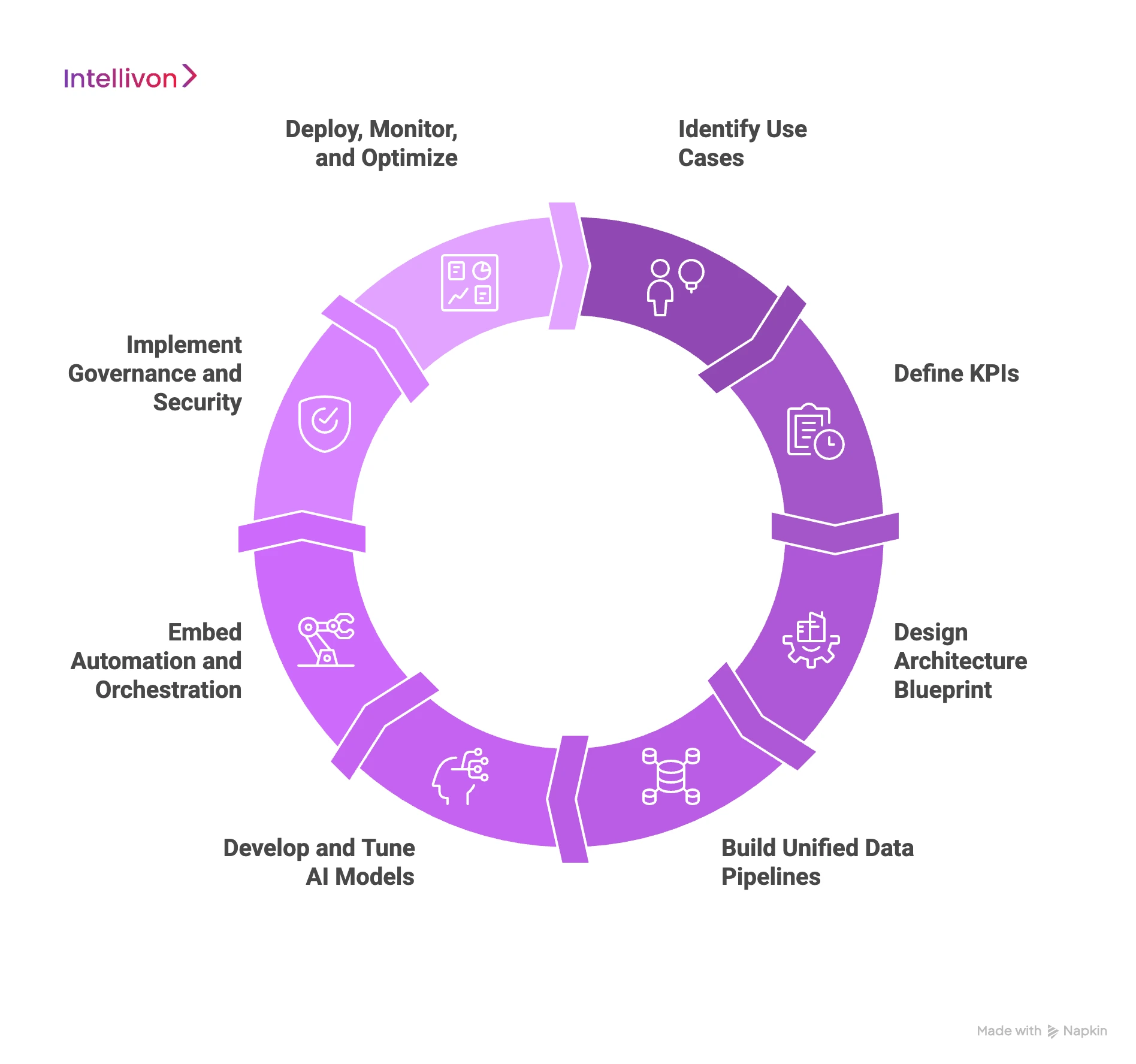
1. Identify Use Cases
We begin by working with enterprise leaders to map areas where AI and automation can create immediate business value. Whether it’s accelerating claims processing, improving fraud detection, or reducing supply chain delays, the focus is always on measurable ROI.
2. Define KPIs
Every project starts with clarity on success metrics and regulatory boundaries. We align KPIs such as cost savings, cycle-time reductions, or accuracy improvements with governance frameworks like GDPR, HIPAA, or SOC2 to ensure compliance is built in, not bolted on.
3. Design Architecture Blueprint
Our architects design a layered blueprint, integrating user experience, AI intelligence, automation orchestration, and governance. This ensures the app is scalable, secure, and aligned with the enterprise IT strategy.
4. Build Unified Data Pipelines
We integrate data from ERP, CRM, SaaS tools, IoT devices, and external sources into governed pipelines. This provides the AI models with high-quality, contextual data, eliminating silos and improving accuracy.
5. Develop and Tune AI Models
We adapt AI models for specific business needs using fine-tuning, retrieval-augmented generation, and domain-specific training. This ensures outputs are not generic, but relevant, explainable, and enterprise-grade.
6. Embed Automation and Orchestration
AI insights only matter when acted upon. We integrate workflow automation, RPA, and decision engines to embed execution directly into enterprise processes. This reduces bottlenecks and accelerates response times.
7. Implement Governance and Security
From audit trails to explainable AI dashboards, we ensure every decision is transparent and every action traceable. Human-in-the-loop controls give enterprises confidence without slowing innovation.
8. Deploy, Monitor, and Optimize
Once deployed, we continuously track technical performance and business KPIs through monitoring dashboards. Retraining pipelines and drift detection ensure the app evolves with changing data, delivering consistent ROI year after year.
This eight-step framework has been proven across industries and global enterprises. By combining intelligence with automation, security with compliance, and architecture with adaptability, Intellivon ensures every app we build is designed to last and to scale.
Cost of Developing Enterprise Apps with AI + Automation
At Intellivon, we understand that enterprises need applications that are both powerful and cost-effective. That’s why our pricing model is flexible and tailored to the requirements of each client, rather than a one-size-fits-all package.
If projected costs risk exceeding your planned budget, we work closely with your teams to refine the scope while safeguarding the core value in productivity, compliance, and operational efficiency.
Estimated Phase-Wise Cost Breakdown
| Phase | Description | Estimated Cost Range (USD) |
| Discovery & Strategy Alignment | Requirement gathering, workflow analysis, KPI mapping, compliance readiness (GDPR, HIPAA, SOC2) | $6,000 – $12,000 |
| Architecture & Design | Blueprint design, layered architecture planning (interaction, orchestration, data, governance), integration mapping | $8,000 – $15,000 |
| Core Workflow Development | Building modular, reusable enterprise actions (e.g., claims automation, fraud detection, order processing) with schema and guardrails | $12,000 – $25,000 |
| AI/ML Model Integration | Model selection, fine-tuning, retrieval pipelines, model routing for accuracy and cost efficiency | $10,000 – $20,000 |
| Workflow Orchestration Engine | Logic for multi-step automation, task execution, validation, and audit logging | $10,000 – $22,000 |
| Platform Development & Customization | Dashboards, ERP/CRM connectors, role-based workflows, user-facing interfaces (Teams, Slack, ERP apps) | $12,000 – $25,000 |
| Security & Compliance Alignment | Encryption, access control, regulatory frameworks (GDPR, HIPAA, SOX), monitoring and audit tools | $8,000 – $15,000 |
| Testing & Validation | Scenario simulations, compliance audits, workflow stress-testing, performance tuning | $6,000 – $10,000 |
| Deployment & Scaling | Cloud rollout, data residency setup, enterprise-wide embedding, monitoring dashboards | $6,000 – $12,000 |
Total Initial Investment Range: $50,000 – $150,000
Ongoing Maintenance & Optimization (Annual): 15–20% of initial build costs.
At Intellivon, we design platforms that align with your budget, enforce compliance, and scale seamlessly with your growth. Request a tailored quote from us today, and we’ll help you design an enterprise app that meets your needs with precision and efficiency.
Overcoming Challenges To Building Enterprise Apps with AI and Automation
Building AI-powered enterprise apps goes far beyond integrating models and automating workflows. The true difficulties often lie in navigating legacy systems, global compliance obligations, scaling costs, and workforce adoption. These are the realities leading enterprises face every day, and without addressing them directly, even the most promising AI initiatives stall before reaching production.
1. Vendor Lock-In and Fragmented Stacks
Many enterprises commit to a single cloud or AI vendor early in their journey, only to realize later that the lack of flexibility increases costs and reduces control. Migrating workloads across providers becomes risky, and sudden price hikes or service limitations can derail long-term strategies. This is especially problematic for global enterprises needing to operate across multiple regions.
Intellivon’s Approach: Instead of forcing vendor dependency, we design vendor-neutral architectures using containerization, orchestration layers, and service mesh. This gives enterprises the ability to route workloads intelligently across providers, optimize cost structures, and comply with regional deployment rules without being trapped.
2. Global Data Residency and Compliance Conflicts
Enterprises operating in multiple geographies must navigate an intricate web of regulatory frameworks, from GDPR in Europe to HIPAA in the U.S. and data localization mandates in Asia. Attempting to centralize sensitive data often creates compliance risks, while fragmented local deployments limit the quality of AI-driven insights. The tension between innovation and regulation becomes a constant battle.
Intellivon’s Approach: Our solution is to deploy regionalized RAG architectures where models access localized knowledge bases instead of relying on centralized stores. This ensures compliance with jurisdiction-specific rules while still allowing enterprises to maintain global consistency in insights and operations.
3. Legacy System Integration
Decades-old ERP systems, custom-built applications, and mainframe processes remain mission-critical for large organizations. Yet these systems were never designed to integrate with modern AI-driven architectures. As a result, many AI pilots operate in isolation, never scaling because they can’t connect to the workflows that matter most.
Intellivon’s Approach: By creating API-first adapters and middleware bridges, we ensure modern AI layers integrate seamlessly with legacy infrastructure. This reduces the risk of disruption, speeds up deployment timelines, and makes it possible for enterprises to extract new value from existing investments without rebuilding core systems from scratch.
4. Model Drift and Performance Decay
AI models that perform well in early pilots can degrade quickly as customer behaviors shift, fraud techniques evolve, or supply chain dynamics change. This leads to declining accuracy, frustrated users, and wasted investment. Without monitoring and retraining, even the most advanced app loses credibility over time.
Intellivon’s Approach: To prevent this, we embed continuous learning pipelines with drift detection, feedback loops, and automated retraining workflows. This allows the app to adapt as the business environment evolves, keeping predictions sharp and ensuring long-term ROI.
5. Cost Overruns at Scale
A pilot project may appear affordable, but once expanded enterprise-wide, hidden costs emerge. High API usage fees, model retraining expenses, and orchestration overheads can multiply quickly. For decision-makers, this creates budget unpredictability and skepticism about scaling beyond the test phase.
Intellivon’s Approach: Our architectures embed cost governance from day one, using techniques like model routing, caching, and batch processing. This ensures enterprises get the same level of performance at scale without runaway costs, making budgets predictable and sustainable.
6. Workforce Adoption and Trust
No matter how advanced an app is, if employees don’t trust the AI’s outputs, adoption falters. Teams hesitate to rely on recommendations they don’t understand, which undermines ROI. Lack of transparency also increases governance risks, as regulators and stakeholders demand accountability in automated decisions.
Intellivon’s Approach: We prioritize explainability and human-in-the-loop design by embedding confidence scores, decision logs, and override controls directly into the UX. Employees can see not just what the app recommends, but why, thereby creating trust, accelerating adoption, and strengthening compliance.
Enterprises rarely fail at AI because of technology itself. They fail when challenges like compliance conflicts, legacy integration, cost governance, or trust are ignored until it’s too late. Intellivon’s frameworks are built around these realities, ensuring the apps we deliver are intelligent, compliant, scalable, and trusted by the workforce that uses them. This is what makes our enterprise deployments succeed where so many initiatives stall.
Conclusion
AI and automation are no longer optional enhancements to enterprise applications. Instead, they are the foundation for scalability, resilience, and long-term ROI. Enterprises that fail to embed these technologies risk operating on outdated, inefficient systems while competitors move ahead with intelligent, adaptive platforms.
The future belongs to organizations that treat apps not just as tools, but as growth engines that learn, adapt, and act in real time.
Build Your Next AI and Automation-Integrated App With Intellivon
At Intellivon, we design enterprise-grade applications that are secure, compliant, and built to transform how global organizations operate. Our platforms don’t just automate workflows — they deliver measurable ROI, strengthen compliance, and unlock innovation at scale without disrupting core systems.
Why Partner with Intellivon?
- Tailored Enterprise Solutions: Every app we build is mapped to your enterprise’s unique workflows, KPIs, and regulatory landscape, no generic templates, only precision-fit platforms.
- Compliance-First Architecture: Designed from the ground up to meet GDPR, HIPAA, SOX, and global audit standards, ensuring governance is enforced, not added later.
- Proven Enterprise Expertise: With 11+ years of building AI-powered platforms and 500+ successful deployments, we bring deep cross-industry experience to every engagement.
- Seamless Integration with Legacy Systems: We specialize in connecting AI and automation layers with ERP, CRM, EHR, and even mainframe systems, ensuring transformation without disruption.
- Cost Governance at Scale: Our platforms embed model routing, caching, and usage monitoring, so enterprises can scale confidently with predictable costs and optimized performance.
- Trust and Transparency: Explainable AI dashboards, human-in-the-loop controls, and auditable decision trails give executives and regulators the confidence to adopt AI widely.
- Scalable and Future-Ready: Cloud-native, API-driven, and built for elasticity, our apps evolve with your enterprise, adapting to new risks, markets, and technologies over time.
Book a discovery call with Intellivon today and see how we can help you build AI and automation-integrated apps that not only streamline operations but also drive long-term growth, compliance, and competitive advantage.
FAQs
Q1. What is the ROI of building an enterprise app with AI and automation?
A1. ROI varies depending on scope, but enterprises typically see 1.5x to 3x returns within two to three years. Gains come from reduced manual workloads, lower compliance costs, faster decision cycles, and improved customer engagement. Measuring ROI involves tracking KPIs like cost per process, cycle-time reduction, and error rate improvements.
Q2. How do AI and automation improve enterprise app scalability?
A2. AI models process data patterns at speed, while automation executes workflows without manual intervention. This allows apps to scale across global operations without additional headcount. Features like model routing, RAG pipelines, and orchestration engines ensure the system grows in capacity without growing in cost.
Q3. What industries benefit most from AI-automated enterprise apps?
A3. Industries with complex workflows and heavy compliance demands see the biggest gains, like banking, healthcare, retail, manufacturing, telecom, and logistics. For example, in banking, apps powered by AI automate fraud detection, while in healthcare, they accelerate diagnosis and compliance documentation.
Q4. What hidden costs should enterprises watch for when developing AI-powered apps?
A4. Hidden costs often include legacy system integration, data preparation, regulatory compliance, and model usage fees. If not addressed early, these can inflate budgets. Best practices like modular architecture, caching, and compliance-by-design prevent overruns and ensure predictable scaling.
Q5. Can enterprise AI apps integrate with existing ERP and CRM systems?
A5. Yes, but integration is often the most challenging phase. Legacy systems like SAP, Oracle, or custom-built ERPs were not designed for modern AI. By using API-first adapters, middleware, and containerized orchestration, Intellivon ensures AI layers connect seamlessly without disrupting mission-critical operations.

